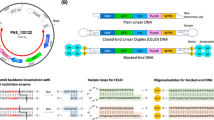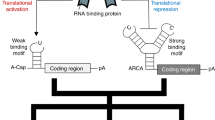Abstract
Although coprecipitates of plasmid DNA and calcium phosphate (DNA:CaPi coprecipitates) were one of the first methods used for transfection of mammalian cells, they are inefficient for many cell types. Based on the recent finding that incorporating recombinant adenovirus in CaPi coprecipitates enhances expression of virus-encoded transgenes, we tested the hypothesis that including adenovirus in DNA:CaPi coprecipitates would increase the efficiency of transfection. We found that including adenovirus at the time of coprecipitate formation increased transgene expression in several cell types. Only a short incubation with cells was required, and the coprecipitates could be delivered in the presence of serum. Inclusion of adenovirus in coprecipitates did not increase DNA uptake by cells, and inactivated virus was also effective. Neutralizing anti-hexon antibody attenuated the enhancement produced by incorporating virus. These data suggest that the virus enhanced expression at a step after cellular uptake, probably by increasing DNA release from endosomes. The DNA:CaPi:Ad coprecipitates were at least as effective as complexes of DNA with adenovirus and polethylenimine or Lipofectin, but produced less cellular toxicity. The results suggest that DNA:CaPi:Ad coprecipitates have advantages for in vitro gene transfer and provide an attractive vehicle for investigating cellular mechanisms of gene transfer.
This is a preview of subscription content, access via your institution
Access options
Subscribe to this journal
Receive 12 print issues and online access
$259.00 per year
only $21.58 per issue
Buy this article
- Purchase on Springer Link
- Instant access to full article PDF
Prices may be subject to local taxes which are calculated during checkout









Similar content being viewed by others
References
Felgner PL et al. Lipofection: a highly efficient, lipid-mediated DNA-transfection procedure Proc Natl Acad Sci USA 1987 84: 7413–7417
Wu CH, Wilson JM, Wu GY . Targeting genes: delivery and persistent expression of a foreign gene driven by mammalian regulatory elements in vivo J Biol Chem 1989 264: 16985–16987
Wolff JA et al. Direct gene transfer into mouse muscle in vivo Science 1990 247: 1465–1468
Gao XA, Huang L . A novel cationic liposome reagent for efficient transfection of mammalian cells Biochem Biophys Res Commun 1991 179: 280–285
Curiel DT et al. High-efficiency gene transfer mediated by adenovirus coupled to DNA–polylysine complexes Hum Gene Ther 1992 3: 147–154
Cotten M et al. High-efficiency receptor-mediated delivery of small and large (48 kilobase) gene constructs using the endosome-disruption activity of defective or chemically inactivated adenovirus particles Proc Natl Acad Sci USA 1992 89: 6094–6098
Wagner E et al. Coupling of adenovirus to transferrin-polylysine/DNA complexes greatly enhances receptor-mediated gene delivery and expression of transfected genes Proc Natl Acad Sci USA 1992 89: 6099–6103
Yoshimura K, Rosenfeld MA, Seth P, Crystal RG . Adenovirus-mediated augmentation of cell transfection with unmodified plasmid vectors J Biol Chem 1993 268: 2300–2303
Loeffler J-P, Behr J-P . Gene transfer into primary and established mammalian cell lines with lipopolyamine-coated DNA Meth Enzymol 1993 217: 599–618
Cristiano RJ, Smith LC, Woo SL . Hepatic gene therapy: adenovirus enhancement of receptor-mediated gene delivery and expression in primary hepatocytes Proc Natl Acad Sci USA 1993 90: 2122–2126
Perales JC et al. Gene transfer in vivo: sustained expression and regulation of genes introduced into the liver by receptor-targeted uptake Proc Natl Acad Sci USA 1994 91: 4086–4090
Gottschalk S, Cristiano RJ, Smith LC, Woo SLC . Folate receptor mediated DNA delivery into tumor cells: potosomal disruption results in enhanced gene expression Gene Therapy 1994 1: 185–191
Boussif O et al. A versatile vector for gene and oligonucleotide transfer into cells in culture and in vivo: polyethylenimine Proc Natl Acad Sci USA 1995 92: 7297–7301
Baker A et al. Polyethylenimine (PEI) is a simple, inexpensive and effective reagent for condensing and linking plasmid DNA to adenovirus for gene therapy Gene Therapy 1997 4: 773–782
Current Protocols in Molecular Biology John Wiley & Sons 1997
Graham FL, van der Eb AJ . A new technique for the assay of infectivity of human adenovirus 5 DNA Virology 1973 52: 456–467
Zabner J et al. Lack of high affinity fiber receptor activity explains the resistance of ciliated airway epithelia to adenovirus infection J Clin Invest 1997 100: 1144–1149
Grubb BR et al. Inefficient gene transfer by adenovirus vector to cystic fibrosis airway epithelia of mice and humans Nature 1994 371: 802–806
Fasbender A et al. Incorporation of adenovirus in calcium phosphate precipitates enhances gene transfer to airway epithelia in vitro and in vivo J Clin Invest 1998 102: 184–193
Greber UF, Willetts M, Webster P, Helenius A . Stepwise dismantling of adenovirus 2 during entry into cells Cell 1993 75: 477–486
Greber UF, Singh I, Helenius A . Mechanisms of virus uncoating Trends Microbiol 1994 2: 52–56
Jordan M, Schallhorn A, Wurm FM . Transfecting mammalian cells: optimization of critical parameters affecting calcium-phosphate precipitate formation Nucleic Acids Res 1996 24: 596–601
Fasbender AJ, Zabner J, Welsh MJ . Optimization of cationic lipid-mediated gene transfer to airway epithelia Am J Physiol 1995 269: L45–L51
Weston SA, Parish CR . New fluorescent dyes for lymphocyte migration studies. Analysis by flow cytometry and fluorescence microscopy J Immunol Meth 1990 133: 87–97
Haugland RP (ed) . Assays for cell viability, proliferation and function In:Handbook of Fluorescent Probes and Research Chemicals 6th edn: Molecular Probes: Eugene, OR 1996 pp 365–398
Gorman C, Padmanabhan R, Howard BH . High efficiency DNA-mediated transformation of primate cells Science 1983 221: 551–553
Brash DE et al. Strontium phosphate transfection of human cells in primary culture: stable expression of the simian virus 40 large-T-antigen gene in primary human bronchial epithelial cells Mol Cell Biol 1987 7: 2031–2034
Zabner J et al. Cellular and molecular barriers to gene transfer by a cationic lipid J Biol Chem 1995 270: 18997–19007
Cotten M et al. Psoralen treatment of adenovirus particles eliminates virus replication and transcription while maintaining the endosomolytic activity of the virus capsid Virology 1994 205: 254–261
Felgner PL, Ringold GM . Cationic liposome-mediated transfection Nature 1989 337: 387–388
Fasbender A et al. Complexes of adenovirus with polycationic polymers and cationic lipids increase the efficiency of gene transfer in vitro and in vivo J Biol Chem 1997 272: 6479–6489
Zabner J, Zeiher BG, Friedman E, Welsh MJ . Adenovirus-mediated gene transfer to ciliated airway epithelia requiresprolonged incubation time J Virol 1996 70: 6994–7003
Author information
Authors and Affiliations
Rights and permissions
About this article
Cite this article
Lee, J., Welsh, M. Enhancement of calcium phosphate-mediated transfection by inclusion of adenovirus in coprecipitates. Gene Ther 6, 676–682 (1999). https://doi.org/10.1038/sj.gt.3300857
Received:
Accepted:
Published:
Issue Date:
DOI: https://doi.org/10.1038/sj.gt.3300857
Keywords
This article is cited by
-
Development of a laboratory scalable process for enhancing lentivirus production by transient transfection of HEK293 adherent cultures
Gene Therapy (2020)
-
High-throughput in situ cell electroporation microsystem for parallel delivery of single guide RNAs into mammalian cells
Scientific Reports (2017)
-
Single-cell electroporation using proton beam fabricated biochips
Biomedical Microdevices (2012)
-
Expression of BHRF1 improves survival of murine hybridoma cultures in batch and continuous modes
Applied Microbiology and Biotechnology (2009)
-
An electroporation microchip system for the transfection of zebrafish embryos using quantum dots and GFP genes for evaluation
Biomedical Microdevices (2007)



